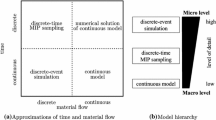Abstract
This paper presents a linear programming approach to analyze and optimize flow lines with limited buffer capacities and stochastic processing times. The basic idea is to solve a huge but simple linear program that models an entire simulation run of a multi-stage production process in discrete time, to determine a production rate estimate. As our methodology is purely numerical, it offers the full modeling flexibility of stochastic simulation with respect to the probability distribution of processing times. However, unlike discrete-event simulation models, it also offers the optimization power of linear programming and hence allows us to solve buffer allocation problems. We show under which conditions our method works well by comparing its results to exact values for two-machine models and approximate simulation results for longer lines.
Similar content being viewed by others
References
Abdul-Kader, W. (2006). Capacity improvement of an unreliable production line–an analytical approach. Computers & Operations Research, 33, 1695–1712.
Altiok, T. (1996). Performance analysis of manufacturing systems. New York: Springer.
Buzacott, J. A., & Shanthikumar, J. G. (1993). Stochastic models of manufacturing systems. Englewood Cliffs: Prentice Hall.
Dallery, Y., & Gershwin, S. B. (1992). Manufacturing flow line systems: A review of models and analytical results. Queuing Systems Theory and Applications, 12(1–2), 3–94. Special issue on queuing models of manufacturing systems.
Gaver, D. (1962). A waiting line with interrupted service, including priorities. Journal of the Royal Statistical Society, 24, 73–90.
Gershwin, S. B. (1994). Manufacturing systems engineering. Englewood Cliffs: PTR/Prentice Hall.
Gershwin, S.B., & Schick, I. (1983). Modeling and analysis of three-stage transfer lines with unreliable machines and finite buffers. Operations Research, 31(2), 354–380.
Gershwin, S. B., & Schor, J. E. (2000). Efficient algorithms for buffer space allocation. Annals of Operations Research, 93, 117–144.
Helber, S. (1999). Lecture notes in economics and mathematical systems : Vol. 473. Performance analysis of flow lines with non-linear flow of material. Berlin: Springer.
Helber, S. (2001). Cash-flow-oriented buffer allocation in stochastic flow lines. International Journal of Production Research, 39, 3061–3083.
Helber, S., & Henken, K. (2010). Profit-oriented shift scheduling of inbound contact centers with skills-based routing, impatient customers, and retrials. Operations Research Spectrum, 32, 109–134.
Ho, Y., Eyler, M., & Chien, T. (1979). A gradient technique for general buffer storage design in production line. International Journal of Production Research, 17, 6 557–580.
Isermann, R. (1987). Digitale Regelsysteme. Band I: Deterministische Regelungen. Berlin/Heidelberg/New York: Springer.
Johri, P. K. (1987). A linear programming approach to capacity estimation of automated production lines with finite buffers. International Journal of Production Research, 25, 851–866.
Kelton, W. D., Sadowski, R. P., & Sturrock, D. T. (2006). Simulation with Arena with CDROM (4th ed.). New York: McGraw Hill.
Law, A. M., & Kelton, W. D. (1991). Simulation modeling and analysis (2nd ed.). New York: McGraw-Hill.
Liberopoulos, G., Papadopoulos, C. T., Tan, B., Smith, J. M., & Gershwin, J. M. (Eds.) (2006). Stochastic modeling of manufacturing systems. Advances in design, performance evaluation, and control issues. Berlin/Heidelberg/New York: Springer.
Matta, A., & Chefson, R. (2005). Formal properties of closed flow lines with limited buffer capacities and random processing times. In J. M. Felix-Teixera & A. E. C. Brito (Eds.), The 2005 European simulation and modelling conference (pp. 190–198), Porto.
Schruben, L. W. (2000). Mathematical programming models of discrete event system dynamics. In J. A. Joines, R. R. Barton, K. Kang, & P. A. Fishwick (Eds.), Proceedings of the 2000 winter simulation conference (pp. 381–385).
Swain, J. J. (2007). Simulation software survey. OR/MS Today, 34(5).
Tan, B. (2003). State-space modeling and analysis of pull-controlled production systems. In S. B. Gershwin, Y. Dallery, C. T. Papadopoulos, & Smith MacGregor, J. (Eds.), Analysis and modeling of manufacturing systems (pp. 363–398). Amsterdam: Kluwer. Chapter 15.
Tijms, H. C. (1994). Stochastic models. Chichester: Wiley.
Tran-Gia, P. (1996). Analytische Leistungsbewertung verteilter Systeme. Eine Einführung. Berlin: Springer.
Author information
Authors and Affiliations
Corresponding author
Additional information
The authors thank the anonymous referees for their very helpful comments and suggestions.
Rights and permissions
About this article
Cite this article
Helber, S., Schimmelpfeng, K., Stolletz, R. et al. Using linear programming to analyze and optimize stochastic flow lines. Ann Oper Res 182, 193–211 (2011). https://doi.org/10.1007/s10479-010-0692-3
Published:
Issue Date:
DOI: https://doi.org/10.1007/s10479-010-0692-3




